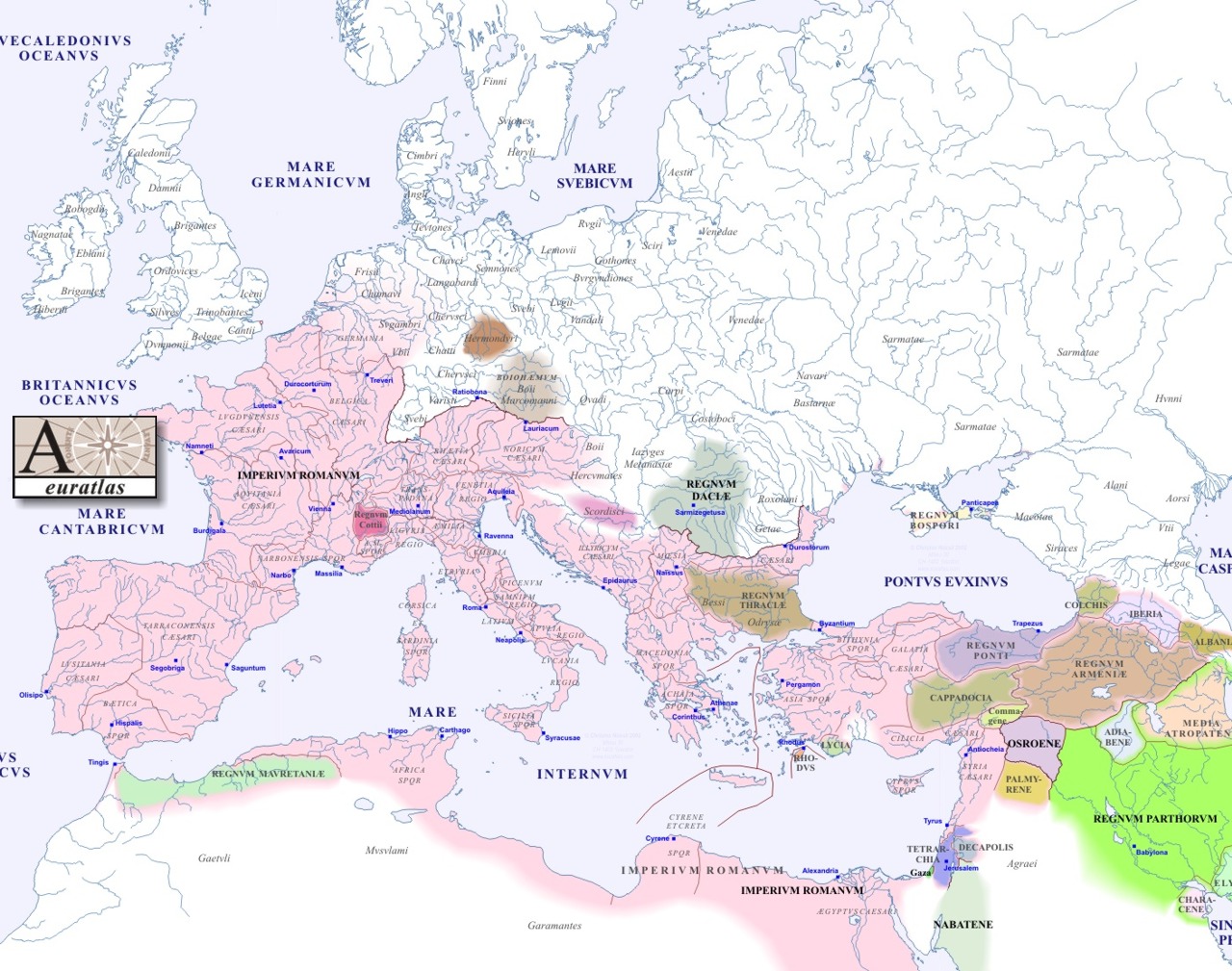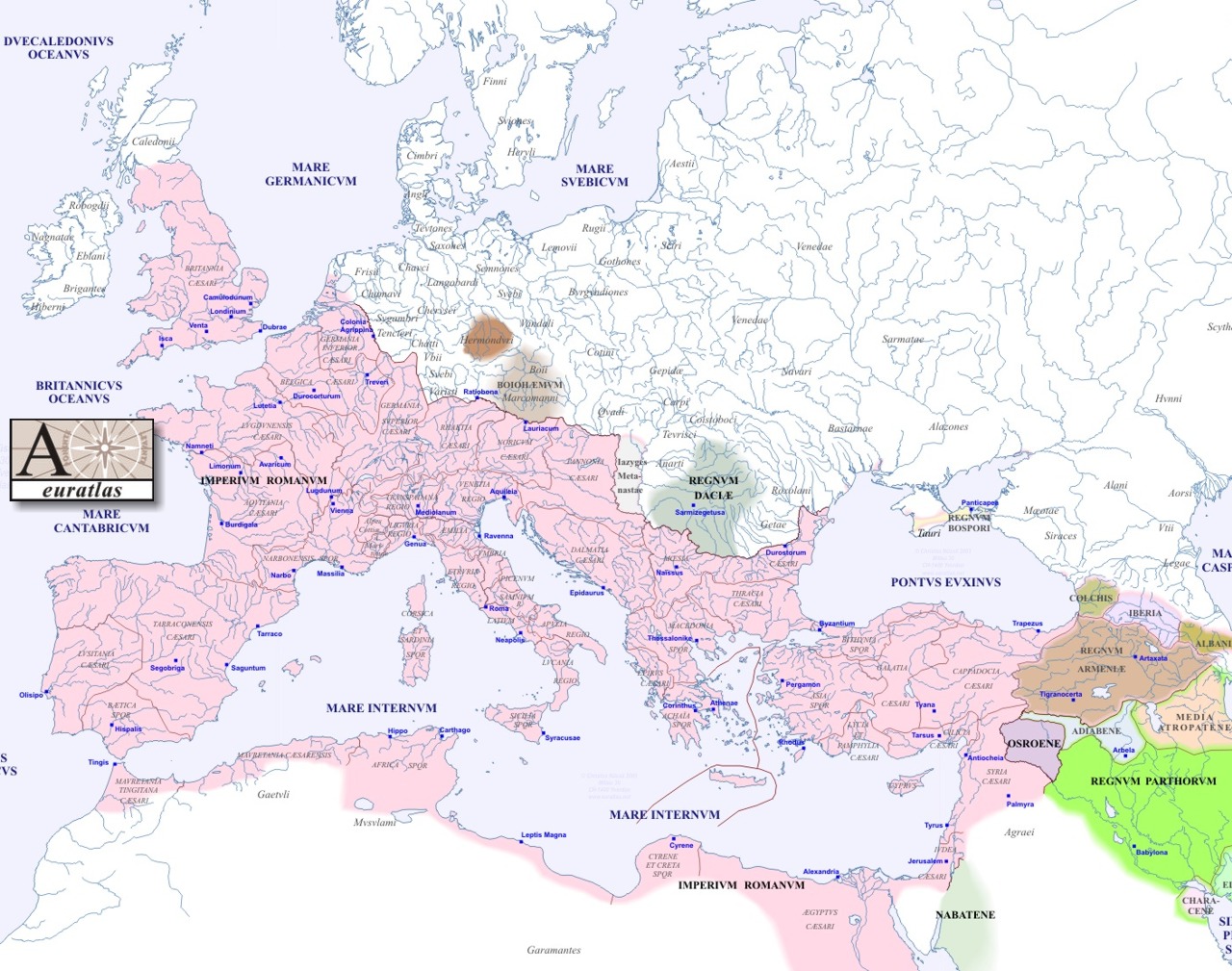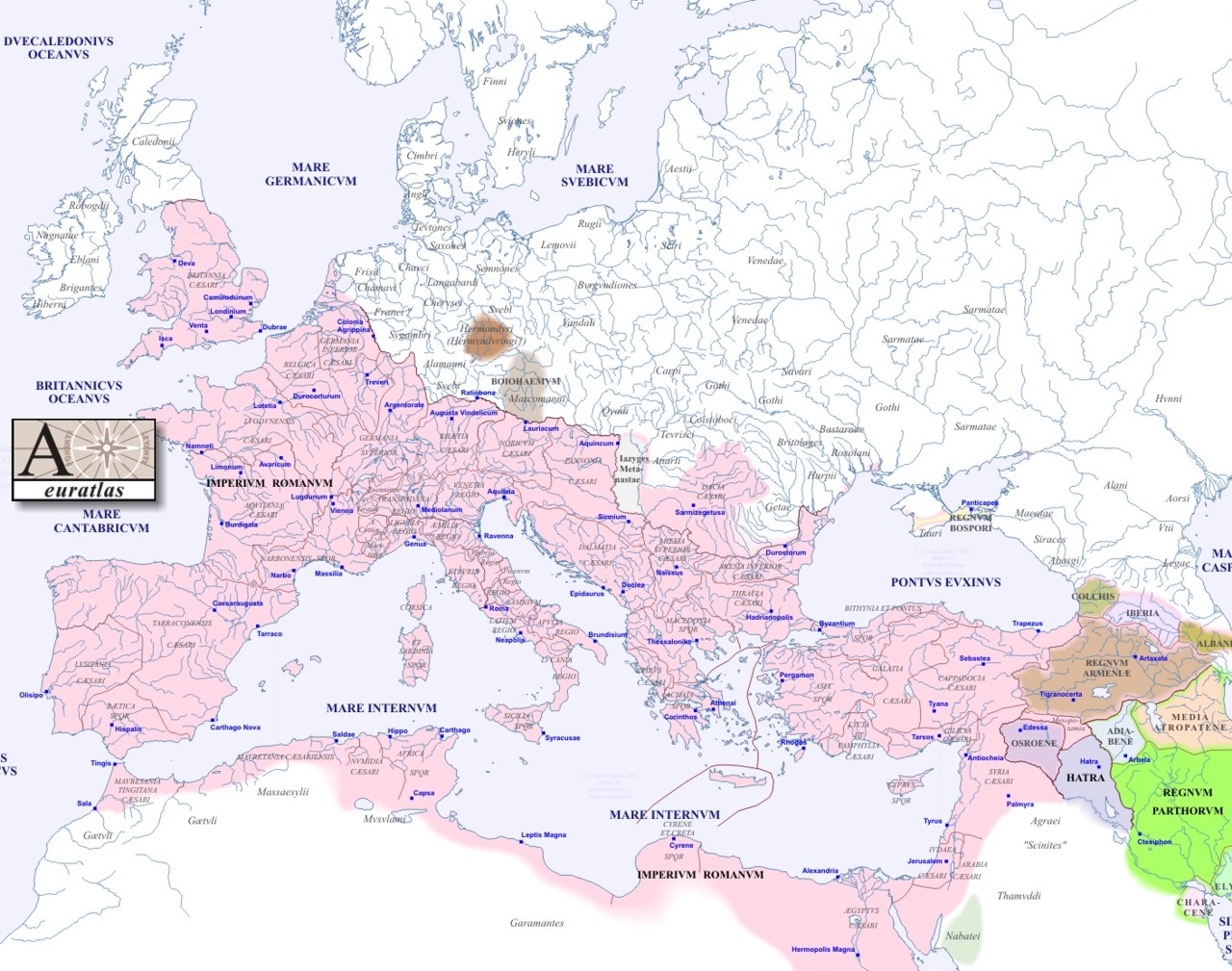| Antenor, King
of the Cimmerians on the Black Sea, d 433BC |
 This pedigree is entirely legend
recorded long after the times and likely just an extract of warriors' campfire
yarns told to inspire the young and handed down from generation to generation,
probably not devoid of truth but rather watered down well mixed with invention.
Like many Germanic peoples, the Franks developed an origin story to connect
themselves with peoples of antiquity. In the case of the Franks, these
peoples were the Sicambri and the Trojans. An anonymous work of 727 called
Liber Historiae Francorum states that following the fall of Troy, 12,000
Trojans led by chiefs Priam and Antenor moved to the Tanais (Don) river,
settled in Pannonia near the Maeotis, now Sea of Azov, and founded a city
called "Sicambria". In just two generations (Priam and his son Marcomer)
from the fall of Troy (by modern scholars dated in the late Bronze Age)
they arrive in the late fourth century at the Rhine. An earlier variation
of this story can be read in Fredegar. In Fredegar's version an early king
named Francio serves as namegiver for the Franks, just as Romulus has lent
his name to Rome.
This pedigree is entirely legend
recorded long after the times and likely just an extract of warriors' campfire
yarns told to inspire the young and handed down from generation to generation,
probably not devoid of truth but rather watered down well mixed with invention.
Like many Germanic peoples, the Franks developed an origin story to connect
themselves with peoples of antiquity. In the case of the Franks, these
peoples were the Sicambri and the Trojans. An anonymous work of 727 called
Liber Historiae Francorum states that following the fall of Troy, 12,000
Trojans led by chiefs Priam and Antenor moved to the Tanais (Don) river,
settled in Pannonia near the Maeotis, now Sea of Azov, and founded a city
called "Sicambria". In just two generations (Priam and his son Marcomer)
from the fall of Troy (by modern scholars dated in the late Bronze Age)
they arrive in the late fourth century at the Rhine. An earlier variation
of this story can be read in Fredegar. In Fredegar's version an early king
named Francio serves as namegiver for the Franks, just as Romulus has lent
his name to Rome. |
| 1. |
Marcomir I, King of the Cimmerians d 412BC |
|
A. |
Antenor, King of the Cimmerians |
|
m. Cambra |
|
i. |
Priamus, King of the Sicambri d 358BC |
|
The tribe changed its name to the
Sicambri in honour of Priamus's mother. |
|
a. |
Helenus, King of the Sicambri d 339BC |
|
1 |
Diocles, King of the Sicambri d 300BC |
|
A |
Bassanus Magnus , King of the Sicambri d 241BC |
|
i |
Clodomir I, King of the Sicambri d 232BC |
|
Holdt shows Clodomir as the husband
of Bassanus's daughter Sedanus. |
|
a |
Nicanor, King of the Sicambri d 198BC |
|
1 |
Marcomir II, King of the Sicambri d 170BC |
|
A |
Clodius I, King of the Sicambri d 159BC |
|
i |
Antenor, King of the Sicambri d 143BC |
|
a |
Clodomir II, King of the Sicambri d 123BC continued
below |
| The Franks enter recorded history
around the year 50 due to an invasion across the Rhine into the Roman Empire.
They are first mentioned on the Tabula Peutingeriana as the Chamavi qui
est Pranci (meaning "Chamavi, who are Pranci", probably an error for Franci). |
|
|
A. |
Clodomir II, King of the Sicambri d 123BC continued
above |
 |
|
i. |
Cassander, King of the Sicambri d 74BC |
|
a. |
Antharius, King of the Sicambri d 39BC |
|
1 |
Francus, King of the Franks d 11BC |
|
The tribe changed its name to the
Franks in his honour. |
|
A |
Clodius II, King of the Franks d 20AD |
|
i |
Marcomir III, King of the Franks d 50AD |
|
a |
Clodomir III, King of the Franks d 63AD |
|
1 |
Antenor, King of the Franks d 69 |
|
A |
Ratherius, King of the Franks d 90 |
|
i |
Richemel, King of the Franks d 114 |
|
Holdt reports that his wife was called
Ascyla. |
|
a |
Odomar, King of the Franks d 128 continued
below |
| Over the next century other Frankish
tribes besides the Chamavi surface in the records. The major primary sources
include Panegyrici Latini, Ammianus Marcellinus, Claudian, Zosimus, Sidonius
Apollinaris and Gregory of Tours. |
|
|
A. |
Odomar, King of the Franks d 128 continued
above |
|
i. |
Marcomir IV, King of the Franks d 149 |

In general Germanic peoples on the borders are known to have served
in the Roman army since the days of Julius Caesar. The tribes at the Rhine
delta that
later became Franks were no exception to that general rule. Despite
the fact that from the 3rd century onward large numbers of Germanic peoples served
in the Roman army, others kept on invading and raiding Roman soil. This caused
con
frontations between Franks and their neighbours on Roman soil such
as the Batavi and Menapii. When Roman administration collapsed in Gaul in the 260's
due to joint invasions of Franks and Alamanni, the Germanic Batavian Postumus
was forced to usurp power and restore order. From that time on Germanic
soldiers in the Roman army, most notably Franks, were visibly promoted from
the ranks.
A few decades later the Menapian Carausius (born in Batavia) created
a Batavian-British rumpstate on Roman soil that was supported by Frankish soldiers
and raiders.
In the mid 4th century Frankish soldiers like Magnentius, Silvanus
and Arbitio held command positions in the Roman military. From the narrative of Ammianus
Marcellinus it becomes clear that both Frankish and Alamannic tribal armies were
organised along Roman lines and fought comparably. |
|
m. 129 Athildus
of Brittany b c90, dau of Coilus, King of Britons |
|
a. |
Clodomir IV, King of the Franks d 166 |
|
Holdt reports that his wife was
Hafilda, princess of Rugij. |
|
1 |
Farabert, King of the Franks d 186 |
|
A |
Sanno, King of the Franks d 213. The Franks (Latin: Franci
or gens Francorum) were a West Germanic tribal confederation first attested
in the third century as living north and east of the Lower Rhine River. |
|
i |
Hilderic, King of the Franks d 253 |
|
a |
Bertherus, King of the Franks d 272 |
|
1 |
Clodius III , King of the Franks d 298 |
|
A |
Walter, King of the Franks d 306 |
|
i |
Dagobert 1, King of the Franks d 317 continued
below |
| From the third to fifth centuries
some Franks raided Roman territory while other Franks joined the Roman
troops in Gaul. Only the Salian Franks formed a kingdom on Roman-held soil
that was acknowledged by the Romans after 357. |
Modern scholars of the Migration Period are in agreement
that the Frankish identity emerged at the first half of the 3rd century
out of various earlier, smaller Germanic groups, including the Salii, Sicambri,
Chamavi, Bructeri, Chatti, Chattuarii, Ampsivarii, Tencteri, Ubii, Batavi
and the Tungri, who inhabited the lower and middle Rhine valley between
the Zuyder Zee and the river Lahn and extended eastwards as far as the
Weser, but were the most densely settled around the IJssel and between
the Lippe and the Sieg. The Frankish confederation probably began to coalesce
in the 210s.
The Salian Franks invaded the Roman Empire and were accepted as Foederati
by Julian the Apostate in 358. By the end of the fifth century, the Salian
Franks had largely moved onto Roman soil to a territory now comprising
of the Netherlands south of the Rhine, Belgium and Northwestern Gaul where,
during the chaos of the migration period, they formed a kingdom, eventually
giving rise to the Merovingian dynasty. Clodius IV , King of the Franks.
Franks appear in Roman texts as both allies and enemies (laeti or dediticii).
Around 250, one group of Franks, taking advantage of a weakened Roman Empire,
penetrated as far as Tarragona in present-day Spain, plaguing this region
for about a decade before Roman forces subdued them and expelled them from
Roman territory. |
|
i. |
Dagobert 1, King of the Franks d 317 continued
above. About seventy years later, the Franks had the region of
the Scheldt river (present day west Flanders and southwest Netherlands)
under control, and were raiding the Channel, disrupting transportation
to Britain. Roman forces pacified the region, but did not expel the Franks,
who continued to be feared as pirates along the shores at least until the
time of Julian the Apostate (358), when Salian Franks were granted to settle
as foederati in Toxandria, according to Ammianus Marcellinus. |

In the climate of the collapse of imperial authority in the West, the
Frankish tribes
were united under the Merovingians and conquered all of Gaul except
Septimania
in the 6th century. The Salian political elite would be one of the
most active
forces in spreading Christianity over western Europe. |
|
a. |
|
|
b. |
Clodomir V, King of the West Franks |
|
1 |
Richimel II, King/Duke of the West Franks d 350 |
|
m. Matilda |
|
A |
Theodomir, King/Duke of the West Franks d 360 |
|
i |
Clodius, King/Duke of the West Franks d 378 |
|
a |
Dagobert, King/Duke of the West Franks d 389 |
|
1 |
Genebald, King/Duke of the West Franks d 419 |
|
A |
Argotta |
EGHJRSWY
|
|
m. Pharamond, King of the Franks d 425just
below |
EGHJRSWY
|
|
c. |
Genebad, Duke of the East Franks d 358 |
|
Genebad not shown by Holdt as Dagobert's
son. |
|
1 |
Dagobert, Duke of the East Franks d 379 |
|
A |
Clodius, Duke of the East Franks d 389 |
|
i |
Marcomir, Duke of the East Franks d 404 |
|
a |
Pharamond, King of the Franks d 425 |
|
m. Argotta dau of Genebald, King/Duke
of the West Franks just above |
This lasted at least till the days of
Procopius, when the Western Roman Empire was gone for more than a century,
because this historian reports that the former Rhine army was still in
operation and that "legions" kept on using the same standard and insignia
as had their forefathers during Roman times.
Militarily, the Franks under the Merovingians melted Germanic
custom with Romanized organisation and several important tactical innovations.
Before their conquest of Gaul, the Franks fought primarily as a tribe unless
they were part of a Roman military unit fighting in conjunction with other
imperial units.
In the 5th century, numerous small Frankish kingdoms existed, among
them the ones
in Cologne, Tournai, Le Mans and Cambrai. The kings of Tournai eventually
came
to subdue the other Frankish kings. This was probably enabled by their
association with Aegidius, the magister militum of northern Gaul; King Childeric
I fights on
Aegidius' side in 463. |
|
1 |
Clodius, King
of the Franks d 445 |
EGHJRSWY
|
|
2+ |
other issue |
| After the invasion of Chlodio the Roman armies at the
Rhine border became a Frankish "franchise", and Franks were known to levy
Roman-like troops that were supported by a Roman-like armour and weapons
industry. |
